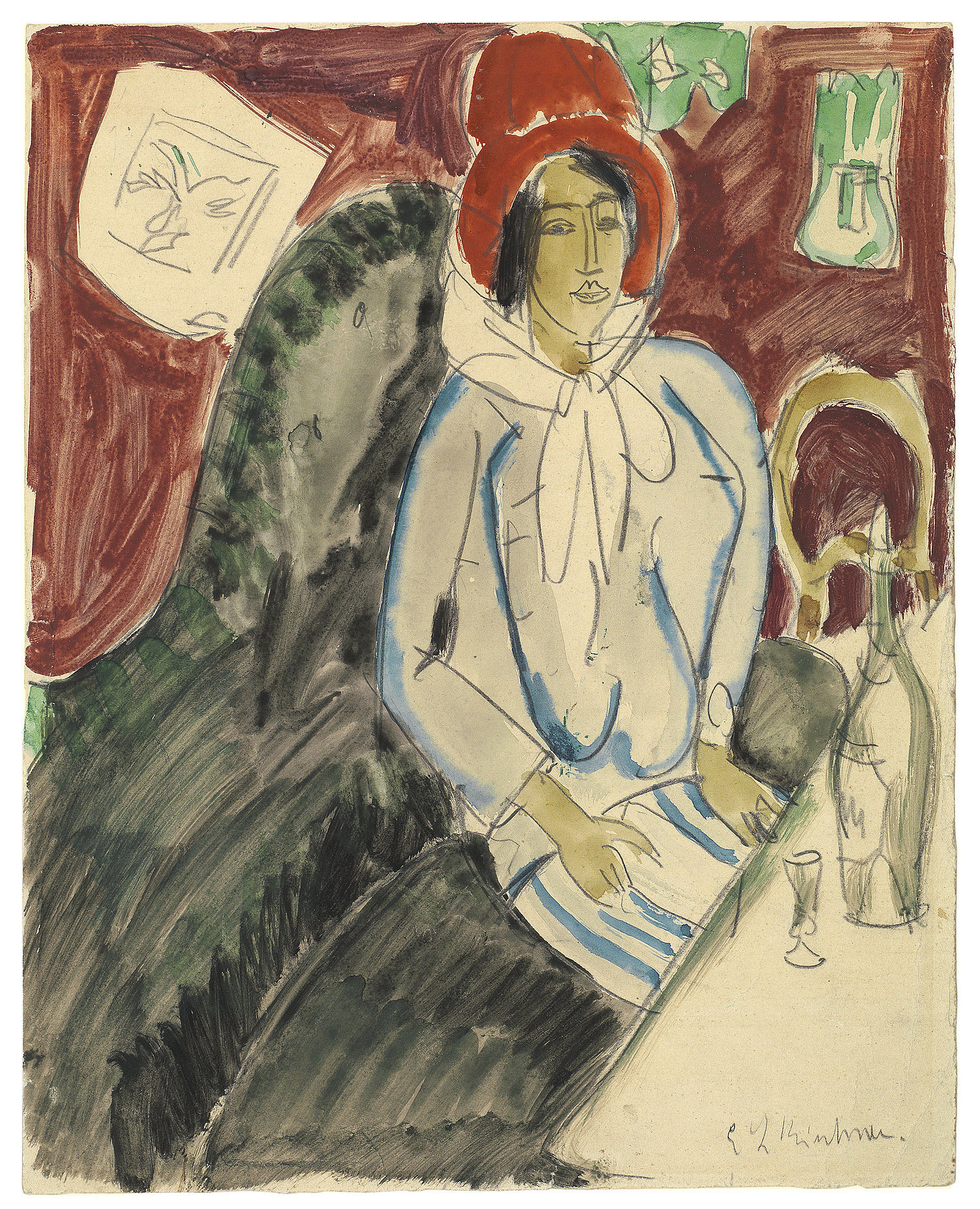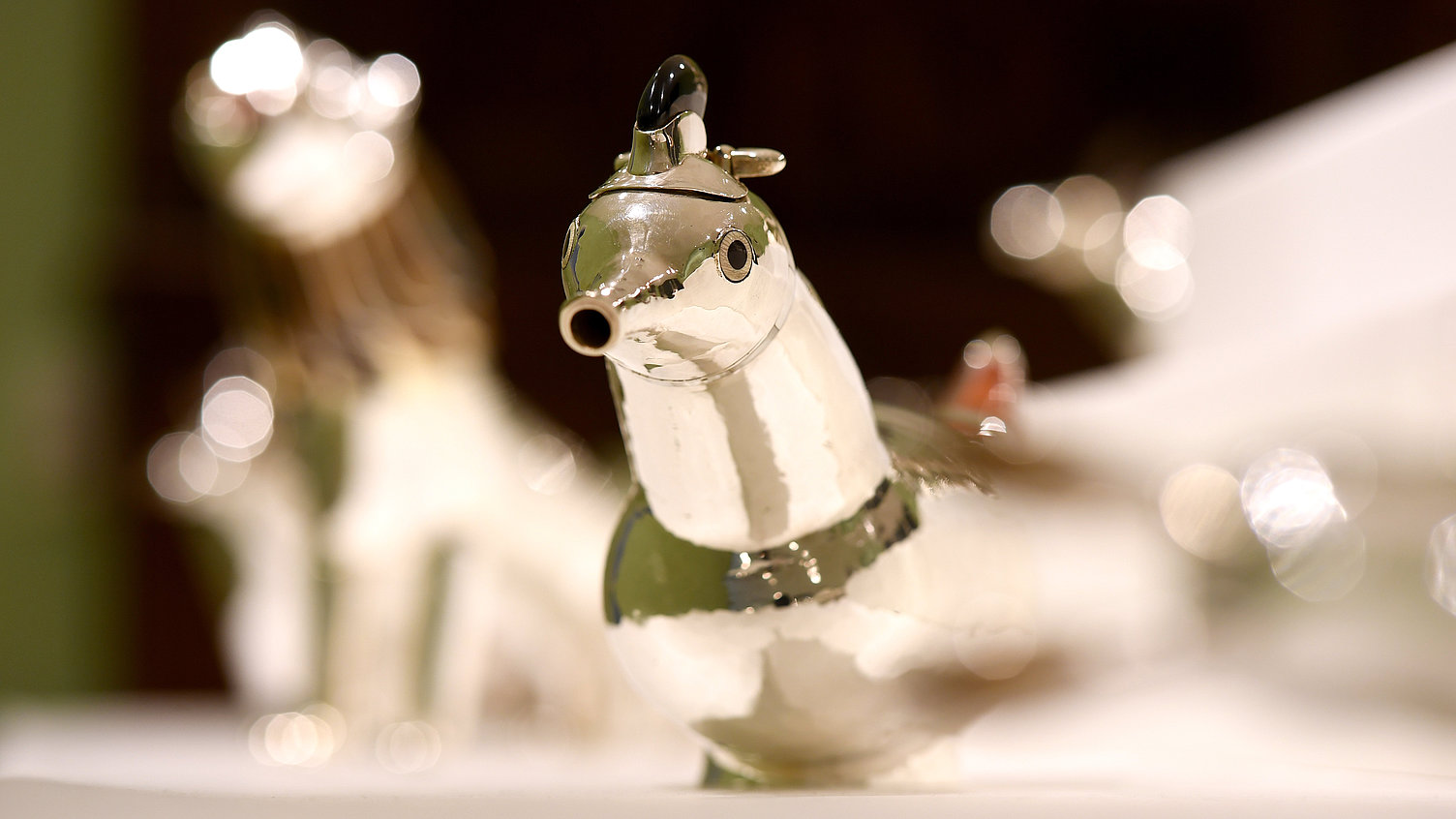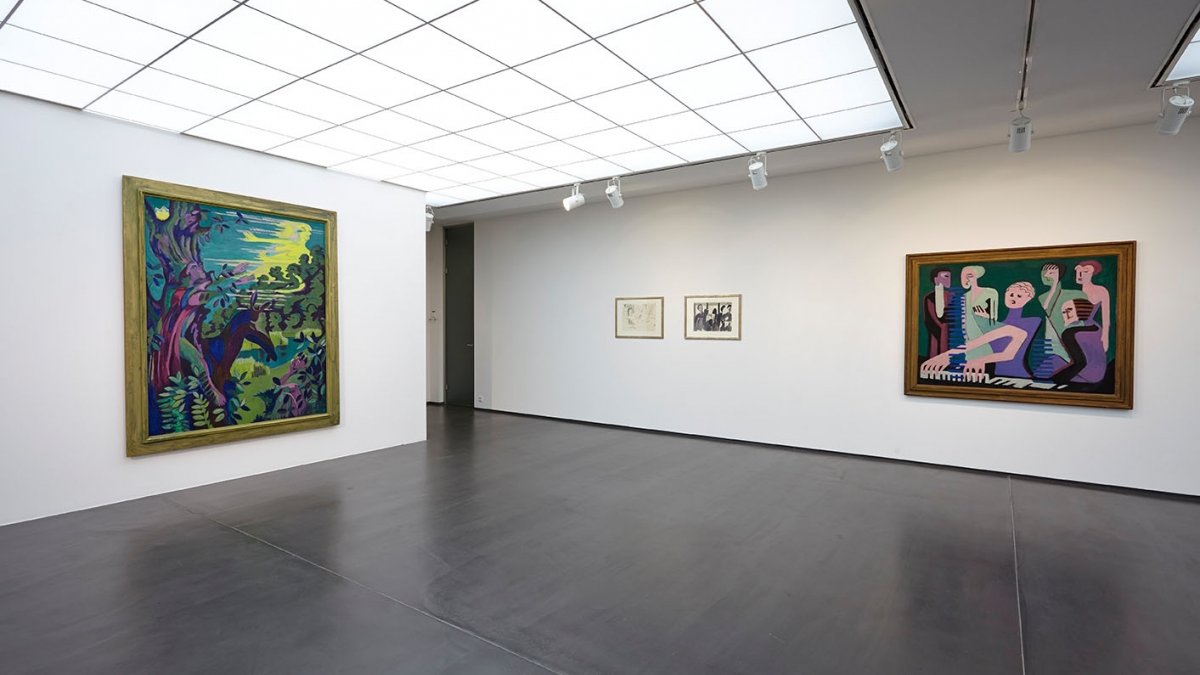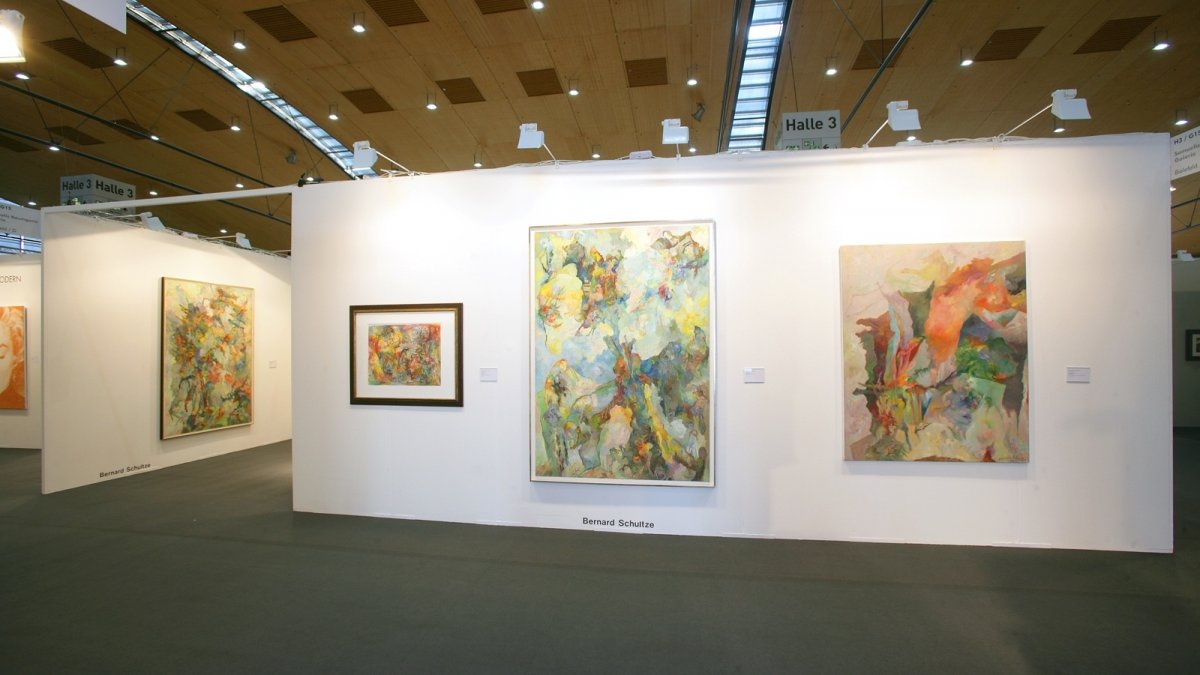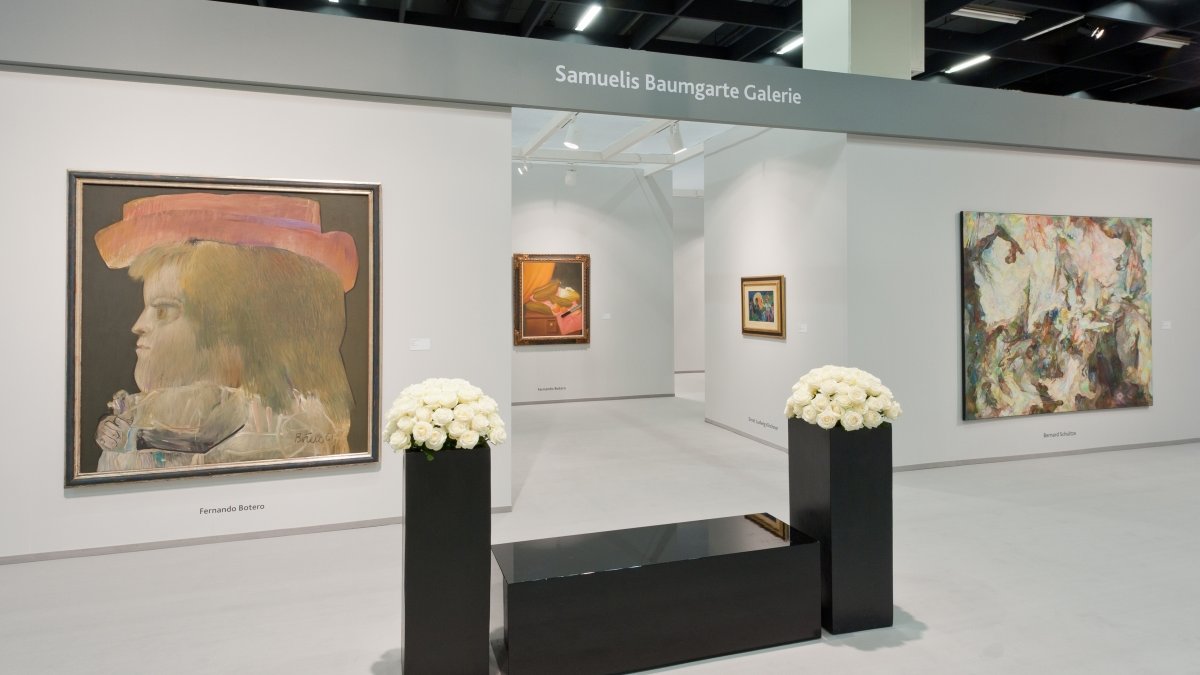Ernst Ludwig Kirchner
Biografie
Ernst Ludwig Kirchner gehört zu den wichtigsten Künstlern der Moderne. 1880 in Aschaffenburg geboren, begann er 1901 das Studium der Architektur an der Königlichen Technischen Hochschule zu Dresden. Er schloss dieses 1905 ab, hatte ein Jahr in der Zwischenzeit aber in München verbracht. Im gleichen Jahr gehörte er, zusammen mit Erich Heckel und Karl Schmitt-Rottluff, zu den Gründern der Künstlervereinigung „Die Brücke“, die gleichbedeutend mit deutschem Expressionismus da steht.
Kirchners Atelier wurde das Zentrum einer damalige Regeln missachtenden Bohème, wo man sich gelegentlich liebte und häufig nackt war. Man zeichnete Akt in Gruppen, die Modelle kamen aus dem Freundes- und Bekanntenkreis. 1913 zeigte Kirchner Arbeiten in der legendären „Armory Show“, seiner ersten größeren Ausstellungsbeteiligung. 1933 erklärten die Nazis sein Oeuvre zur „Entarteten Kunst“ und 600 seiner Werke wurden vernichtet oder über die Schweiz in den internationalen Handel gebracht. 1938 wählte er in Frauenkirch-Wildboden bei Davos den Freitod.
Kirchners Frühwerk zeigt noch Einflüsse des späten Impressionismus. Aber er entwickelte bald seinen expressiven Stil mit starken, lebhaften Farben in deutlichen Kontrasten. Seine Figuren besitzen eine zackige Kontur und gelängte Formen, eine bedeutsame Ähnlichkeit zum Manierismus. Das alles in einer perfekten Mixtur klassischer wie zeitgenössischer Sujets, Sozialkritik eingeschlossen. Er war auch ein fleißiger Grafiker und sogar Bildhauer, und er zeigte sich ebenfalls von der Kunst der Naturvölker beeindruckt, die er im Museum in Dresden hatte sehen können.
Obwohl Kirchner ganz im Zeitgenössischen aufging, besaß er dennoch etwas Zurückgezogenes. In einem Brief aus Davos (1919) schrieb er, dass der belgische Architekt Henry van de Velde ihn aufgefordert habe, ins moderne Leben zurückzukehren. Kirchner schrieb weiter, dass das für ihn nicht in Frage käme, und dass er es auch nicht bedauere. Die Welt, so der Künstler, biete überall die gleichen Freuden, nur ihre äußere Erscheinung sei verschieden. Wo er sich aufhalte, könne er weiter sehen und tiefer gehen als im „modernen Leben“, das, trotz vielfältiger Erscheinungsweisen, doch oberflächlich sei.
In seinen berühmten Landschaften kommen die einzelnen Motive auf der Leinwand zusammen, wie die Menschen in den Straßen. Alle kommen von irgendwo, gehen nach irgendwo, und trägt dabei jeder seine eigene Geschichte mit sich. Die Wiedergabe, vor allem der Straßenszenen, ist meist in der Schräge, leicht gelängt, etwas verzerrt, was den Blick einen langen Weg führt. So erhöht sich der Ausdruckscharakter der Bilder.
Über seine Kunst schrieb er: „Jedes Bild, das ich schaffe, hat seinen Ursprung in einem Naturerlebnis. Hier gilt mir der Satz DÜRERS: Alle Kunst kommt aus der Natur, wer sie heraus kann reißen, der hat sie. Natur ist für mich alles Sichtbare und Fühlbare in der Welt, der Berg wie das Atom, der Baum und die Zelle, die ihn baut, aber auch alles von Menschen Geschaffene, wie Maschinen usw. Alle biologische, technische, wissenschaftliche Erkenntnis ist wertvoll für meine Arbeit, doch ist mein Verhältnis ein durchaus anderes zu ihr als das des Biologen oder Ingenieurs. Das moderne Licht der Städte, in Verbindung mit der Bewegung der Straßen, gibt mir neue Anregungen. Es breitet sich eine neue Schönheit über die Welt, die nicht in der Einzelheit des Gegenständlichen liegt. Durch die Schulung an diesem so reichen Problem bekam auch die freie Natur draußen ein anderes Gesicht für mein Auge. Aus der Beobachtung der Bewegung kommt mir das gesteigerte Lebensgefühl, das der Ursprung des Kunstwerks ist.“
Wenn Kirchner das Lebensgefühl als Quelle des Kunstwerks nennt, wird klar, dass seine ganze Kreativität unter diesem Primat steht und dass die Schönheit eines Werks aus dem Zusammenfall der Effekte mit den Gefühlen entsteht, nicht von klassischen Kategorien wie Symmetrie und Harmonie regiert wird. Expressionismus bedeutet, in der Tat, eine untrennbare Verbindung zur Wolke des Gefühlten im Bewusstsein des Künstlers. Das ist dem „inneren Monolog“ verwandt, den Schriftsteller wie James Joyce angewendet haben („Ulysses“, 1922).Kirchner malt mit Farben, die er wegen ihrer Gefühlswerte aussucht, und mit Formen wegen ihrer Ausdrucksstärke. So ist seine Kunst auch eine Selbstverwirklichung, aber innerhalb eines sozial kommunikativen Zusammenhanges.
Kirchner malt mit Farben, die er wegen ihrer Gefühlswerte aussucht, und mit Formen wegen ihrer Ausdrucksstärke. So ist seine Kunst auch eine Selbstverwirklichung, aber innerhalb eines sozial kommunikativen Zusammenhanges.
Ich bin tief eingedrungen in die Geheimnisse der Darstellung und meine Stellung zur Kunst ist heute klar und bewusst, wo sie früher instinktiv war.

Ausstellungen
Messen
Museumsausstellungen (Auswahl)
Ernst Ludwig Kirchner. Der Maler als Fotograf, 02.03.2019 - 16.06.2019, Museum der Moderne Salzburg.
Ernst Ludwig Kirchner: Erträumte Reisen, 16.11.2018 - 17.02.2019, Bundeskunsthalle, Bonn
Ernst Ludwig Kirchner: Die unbekannte Sammlung, bis 21.10.2018, Staatsgalerie Stuttgart, Stuttgart
Kirchner und die Brücke, bis 16.09.2018, Staatsgalerie Stuttgart, Stuttgart
Wow! The Heidi Horten Collection, bis 29.07.2018, Leopold Museum, Wien
Ernst Ludwig Kirchner: Modelle, Akte und Kokotten, 02.07.2016 - 03.10.2016, Stadthalle Balingen
Farbenrausch: Meisterwerke des deutschen Expressionoismus, bis 11.01.2016, Leopold Museum, Wien
Eine ganze Nationalgalerie des Expressionismus. Die Sammlung Buchheim in Emden, 26.09.2015 - 17.01.2016, Kunsthalle Emden, Emden
Gipfeltreffen. Ernst Ludwig Kirchner und Bernd Zimmer, 18.07.2015 - 11.10.2015, Buchheim Museum der Phantasie, Bernried am Starnberger See
Ernst Ludwig Kirchner. Energie der Linie, 28.06.2015 - 27.09.2015 , Franz Marc Museum Kunst im 20. Jahrhundert, Kochel am See
ImEx. Impressionismus x Expressionismus. Kunstwende, 22.05.2015 - 20.09.2015, Staatliche Museen zu Berlin
Auszeit: Vom Faulenzen und Nichtstun, 29.04.2015 - 19.07.2015, Sprengel Museum, Hannover
Kraft der Linie: Graphik des Expressionismus, 27.02.2015 - 31.05.2015, Kunsthalle Mannheim
Der doppelte Kirchner: Die zwei Seiten der Leinwand, 06.02.2015 - 31.05.2015, Kunsthalle Mannheim, Mannheim
Das (verlorene) Paradies. Expressionistische Visionen zwischen Tradition und Moderne, bis 17.05.2015, Kunsthaus Stade
Ernst Ludwig Kirchner in den Kunstsammlungen Chemnitz, bis 19.04.2015, Kunstsammlungen Chemnitz Museum Gunzenhauser, Chemnitz
Arche Noah - Über Tier und Mensch in der Kunst, 15.11.2014 - 12.04.2015, Museum Ostwall im Dortmunder U, Dortmund
Bogenschießen. Ernst Ludwig Kirchner und andere, bis 08.03.2015, Museum Biberach Braith-Mali-Museum, Biberach an der Riß
Apocalypse Now!, bis 15.02.2015, Museum Pfalzgalerie Kaiserslautern
Von Rembrandt bis Richter: Meisterblätter der Grafischen Sammlung, bis 18.01.2015, Landesmuseum für Kulturgeschichte Oldenburg
Premiére - Die Sammlung Würth in Rorschach, 28.04.2014 - 15.01.2015, Forum Würth Rorschach, Schweiz
Weltenbruch: Die Künstler der Brücke im Ersten Weltkrieg, bis 16.11.2014, Brücke Museum, Berlin
Kirchner, Schmidt-Rotluff, Heckel und Pechstein lassen grüßen!, bis 02.11.2014, Osthaus Museum, Hagen
Expressionistische Begegnung: Ernst Ludwig Kirchner - Jan Wiegers, 06.07.2014 - 28.09.2014, Staatliches Museum Schwerin, GalerieAlte & Neue Meister, Schwerin
German Expressionism: A Revolutionary Spirit, bis 14.09.2014, The Baltimore Museum of Art, USA
Kirchner. Das expressionistische Experiment, 29.05.2014 - 07.09.2014, Bucerius Kunst Forum, Hamburg
Kirchner im Schaffensdrang, 22.05.2014 - 31.08.2014, Pinakothek der Moderne, München
1900-1914. Das kurze Glück vor dem großen Krieg, 28.03.2014 - 29.06.2014, Schweizerisches Nationalmuseum, Zürich
E. L. Kirchner - Linie und Leidenschaft, noch bis 04.05.2014, Museum Pfalzgalerie, Kaiserslautern
Georg Baselitz: Besuch bei Ernst Ludwig, bis 21.04.2014, Kirchner Museum Davos, Davos
Highlights aus der Museumssammlung, 12.09.2013 - 16.02.2014, Von der Heydt-Museum, Wuppertal
1914. Die Avantgarden im Kampf, bis 23.02.2014, Kunst- und Ausstellungshalle der BRD, Bonn
Zwischen Brücke und Blauer Reiter, bis 23.02.2014, Zentrum Paul Klee, Bern, Schweiz
Bilder des Aufbruchs, 07.11.2013 - 09.02.2014, Lehmbruck Museum, Duisburg
Wie-Berlin: Kunst zweier Metropolen, bis 27.01.2014, Berlinische Galerie, Berlin
Eiskalte Emotionen - Werke aus der Sammlung Frank Brabant zwischen Expressionismus und Verismus, bis 26.01.2014, Museum der Stadt Aschaffenburg, Aschaffenburg
Kirchners Sammler, Mäzene, Museum. bis 21.06.2013, Kirchner Museum Davos, Davos
Die eigene Sammlung: Gemälde und Plastik der Brücke-Künstler, bis 09.06.2013, Brücke Museum, Berlin
Junge Pferde! Junge Pferde! Kunst auf dem Sprung ins 20. Jahrhundert, 09.02.2013 - 26.05.2013, Edwin Scharff Museum, Neu-Ulm
Expressionisten aus der Sammlung Dr. Alfred Gunzenhauser Chemnitz, bis 07.04.2013, Kunstmuseum Heidenheim, Heidenheim an der Brenz
Highlights aus der Museumssammlung, bis März 2013, Von der Heydt-Museum, Wuppertal
Im Netzwerk der Moderne, bis 06.01.2013, Staatliche Kunstsammlungen Dresden
Expressionismus & Expressionismi: Berlin-Munich 1905 – 1920, Der Blaue Reiter vs. Brücke, 13.10.2011 – 11.03.2012, Pinacothèque de Paris




